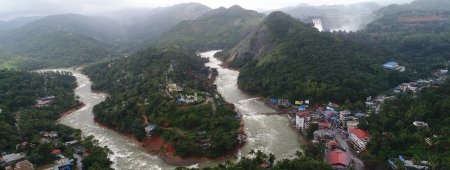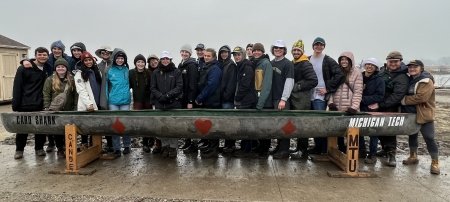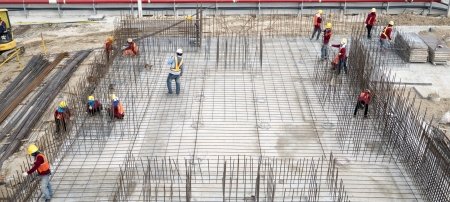Around the world and close to home, here is the breadth of research happening at Michigan Tech in health sciences, mobility, environmental science, materials engineering, physics, geoscience, and civil engineering.
Research Highlights 2019
This past year, Michigan Tech reached an all-time high for research expenditures, totaling $80.4 million.
- New Colleges: The College of Computing opened in July 2019, then in November two schools became the College of Business and the College of Forest Resources and Environmental Science. The growth meets demand for interdisciplinary teaching and research.
- Golden Proving Ground: The Keweenaw Research Center installed a new course for military ground-vehicle testing. From steep hills to deep puddles, from rocky terrain to sand pits, the crew takes vehicles truly off road.
- SubT Winner: Defense Advanced Research Projects Agency (DARPA) takes robots underground in the Subterranean Challenge (SubT). A team from the Michigan Tech Research Institute (MTRI) is competing in the virtual track and took second place the October 2019 round.
- Mobility: The Advanced Power Systems Laboratory (APS LABS) and the Center for Technology and Training (CTT) tackle everything from the details of powertrain efficiency to infrastructure management with nearly $5 million in new federal and state agency grants this year.
Heartfelt Tissue Engineering
2.5 billion. That’s approximately the number of times the human heart beats in 70 years. And sometimes during the course of its unrelenting contractions and relaxations, the heart muscle can no longer bear the strain.
There’s more than one way to fix a broken heart. For Michigan Tech engineers, the solutions they develop in the lab could help patients recover from heart attacks. It all comes down to engineering a tissue that works: from the tissue’s nutrient availability, to its growth environment, to biocompatible substrates.
If heart muscle cells—cardiomyocytes—could be repaired by cells taken from one’s own body, the patient’s recovery improves. But manufacturing heart cells requires an exacting process tailored specifically to an individual, and the environment that the cell is grown in matters. Parisa Pour Shahid Saeed Abadi, assistant professor of mechanical engineering, takes old petri dish growing methods into three dimensions.
“On day one we start seeing the effect of the substrate on the morphology of the cells,” Abadi says, explaining she uses a process called photolithography to shape the mold to grow heart cells in. “I use microfabrication and nanofabrication techniques to tackle problems that are challenging for biologists or clinicians to address.”
Interdisciplinary work is inherent within health tech development and Smitha Rao, assistant professor of biomedical engineering, turns to materials science and biochemistry to also improve ways to grow strong heart muscle cells. Her team developed an electrospun nanofiber using a specific polymer blend that creates ideal conditions for many kinds of cells.
“We’re trying to simplify the process to answer a highly complex question: How do cells proliferate and grow?” Rao says. “This is our basic building block; this is the two-by-two Lego. And you can build whatever you want from there.”
For Feng Zhao, associate professor of biomedical engineering, better engineering is inspired by the tissue’s network of tiny veins, capillaries, and nutrient-providing microvessels.
“The significance of microvessel organization in 3D scaffolds has largely been ignored,” Zhao explains. “Understanding the mechanisms behind microvessel alignment in biomaterials will help us and other biomedical engineers to create better, more refined implants and devices.”
Red, Gray, and Isolated
Islands make gene pools dance. From Isle Royale in Lake Superior to Galveston Island in the Gulf of Mexico, ecologists in the College of Forest Resources and Environmental Science examine the interweaving patterns of wolf genetics.
“Our discovery that red wolf genes have persisted in Texas—after being declared extinct in the wild—was very surprising,” says Kristin Brzeski, assistant professor of wildlife ecology. “It introduces both positive opportunities for additional conservation action and difficult policy challenges.”
Brzeski and her team found that isolation from mainland coyotes likely concentrated red wolf genetics within a canid group on Galveston Island. Isolation was the downfall, however, for the gray wolves on Isle Royale. The National Park Service worked with regional partners this past year to bring new wolves to the remote island, now up to 17 wolves. The annual Isle Royale Winter Study, now in its 62nd year and led by researchers John Vucetich, Sarah Hoy, and Rolf Peterson, will continue to document the island’s predator-prey dynamics.
AI For Nanomaterials
Faster computers. Longer battery life. Wearable tech. The power to look deep into the atomic structure of materials for these uses is more accessible than ever. But getting a material to the microscope is a long road. What if new materials could be invented before they’re seen?
Artificial intelligence (AI) and machine learning could make it possible. Yoke Khin Yap, professor of physics, is leading a team to model new nanomaterials then vet, develop, and test them.
“It is complicated and it will become a very interdisciplinary collaboration between theorists, computer scientists, experimental physicists, and chemists to make the new nanomaterials,” Yap says, adding that coupling AI with experimentation “brings together all the kinds of theory out there and we find there is a subset that potentially more people agree upon.” Yap’s collaborators are Ranjit Pati from physics, Ravindra Pandey from physics, Susanta Ghosh from mechanical engineering, and Tim Havens from computing.
Supreme Court of Concrete
The American Concrete Institute (ACI) Committee 318 writes the building code for concrete construction. In the world of concrete, where life safety is at stake, the committee is the Supreme Court, establishing the rules that are followed universally in the US and also in many other countries around the world. The members of Committee 318 often serve for the rest of their careers and they make important recommendations for safe design and construction of buildings, which are widely adopted around the globe.
Tess Ahlborn, professor of civil and environmental engineering, is ACI 318’s latest addition.
Following the 1906 earthquake in San Francisco, buildings made of concrete reinforced with steel, known as rebar, spread across the nation and world because of how well they withstand the forces of nature. Today, concrete is the number one building material.
“We think of concrete almost as rock, but a big part of it is the steel,” Ahlborn says. “It’s a steel frame encased in concrete. And people the world over need to know, ‘How do I design with it?’ and ‘How does it behave?’ The code has happened with over 100 years of research.”
Mobility and Transportation
Mobility is the movement of goods, people, and information. Transportation is more than starting the ignition. In terms of infrastructure, bridges are a challenge.
In the latest American Road and Transportation Builders Association report, more than 47,000 bridges in the US are structurally deficient and need repairs. Across Michigan, 75 percent of highway bridges are at least 40 years old. The Michigan Department of Transportation (MDOT) has partnered with research scientists at Michigan Tech Research Institute (MTRI) and Michigan Tech engineers.

3DOBS Bridge Deck Assessment
3DOBS is a cinema-quality camera attached to a pole braced on a vehicle trailer hitch that rises up nine feet above the ground. The RED 8K camera captures up to 60 frames per second and picks up details as small as millimeter-wide cracks in the pavement as the truck drives over the bridge deck. 3DOBS is one way to ensure timely bridge monitoring.
As team leader and MTRI research scientist Rick Dobson puts it, “On any vehicle with a standard trailer hitch, you can mount the camera and go.”
3D Bridge App
Drones make bridge inspections safer and easier to document. A complementary 3D bridge app developed by the MTRI also streamlines defect records. There is no replacing people in the assessment—human eyes and judgement are necessary—but technology can speed up and make bridge inspections safer, helping set aside more time and money to fix structurally deficient bridges.
“We need to know if we can get from point A to point B,” says MTRI research scientist Colin Brooks. “An important component of mobility is being able to understand whether or not the transportation system you’re looking at can effectively move goods and people based on the condition of the infrastructure.”
Connected Vehicles
“Connected vehicle technologies also have the potential to optimize traffic, reduce congested areas and promote reduced fuel consumption,” says Aurenice Oliveira, associate professor of electrical and computer engineering.
Newer cars are most likely connected: GPS navigation, infotainment panel, wireless network—they’re all ways for a vehicle to provide information, whether to give directions, ping other vehicles or check in with infrastructure like traffic signals, signs or bridges.
All of this data creates the potential for connected cars to help transportation planners.
Kuilin Zhang, associate professor of civil and environmental engineering and affiliated associate professor of computer science, fills in the data gaps by reconstructing a vehicle’s missing location-duration-path choices.

Autonomous and Connected Vehicles Hit the Road
Mobility is the movement of goods, people, and information. Our researchers take mobility into unstructured environments and test their limits.
Michigan Tech Research Around the World
Disaster Relief in India
India is in a unique position with climate change. It’s a densely populated country that is prone to geohazards like earthquakes, tsunamis, landslides, and floods. Because of that density, one disaster can hurt a lot of people, as happened last August when a mudslide in southern India killed 66 people and flash floods displaced at least 360,000.
Mumbai alone has a population of 19 million people, but only one university there, the Tata Institute of Social Sciences (TISS), offers a degree in disaster management and mitigation.
“This is a pressing need,” says Thomas Oommen, associate professor of geological and mining engineering sciences and affiliated associate professor of civil and environmental engineering at Michigan Tech. “Technologies used today in disaster management need to be taught to students so they can be ready for when a disaster hits a community this large.”
Oommen was given a grant from the US Consulate General in Mumbai to travel there, along with Tim Frazier from Georgetown University and Himanshu Grover from the University of Washington, to meet with faculty and administration from TISS as well as Indian officials. For two weeks in August 2019, they worked to identify gaps in the TISS program and develop a state-of-the-art disaster management curriculum to be implemented at TISS. They continue to meet via an online portal every month to continue work on the curriculum, which they hope can then be replicated at universities across India to train more people to handle the disasters to come.
Drought and Nanotech in El Salvador, Denmark, Singapore
The National Science Foundation’s International Research Experience for Students (IRES) dives into interdisciplinary research.
IRES Denmark and IRES Singapore
- Led by Caryn Heldt, director of the Health Research Institute and the James and Lorna Mack Chair in Bioengineering, and Erin Smith, director of the Humanities Digital Media Zone
- Three cohorts: 2017-2019
- Collaborators: Aarhus University in Denmark and the National University of Singapore
- The teams examined biomedical applications of nanotechnology for detecting and treating viral diseases.
- A communications student also joined the team each summer to produce a short documentary and help the STEM-focused members learn effective social media and outreach tools.
- Led by John Gierke, chair of the Department of Geological and Mining Engineering and Sciences, with the Consortium of Universities for the Advancement of Hydrologic Sciences, Inc. (CUAHSI) and Lutheran World Relief (LWR)
- Three cohorts: 2020-2022
- Collaborators: Luke Bowman, geology; Kari Henquinet, Pavlis Honors College; Angela Carter, social sciences; Frank Liu, forestry; David Watkins and Alex Mayer, civil and environmental engineering; researchers at the University of El Salvador FMP in San Vicente; CUAHSI and LWR professional staff
- The teams seek to understand the impacts of drought and extreme weather on water use in rural ag communities in the Central American Dry Corridor and explore adaptation strategies to improve water access.
Michigan Technological University is an R1 public research university founded in 1885 in Houghton, and is home to nearly 7,500 students from more than 60 countries around the world. Consistently ranked among the best universities in the country for return on investment, Michigan's flagship technological university offers more than 120 undergraduate and graduate degree programs in science and technology, engineering, computing, forestry, business, health professions, humanities, mathematics, social sciences, and the arts. The rural campus is situated just miles from Lake Superior in Michigan's Upper Peninsula, offering year-round opportunities for outdoor adventure.










